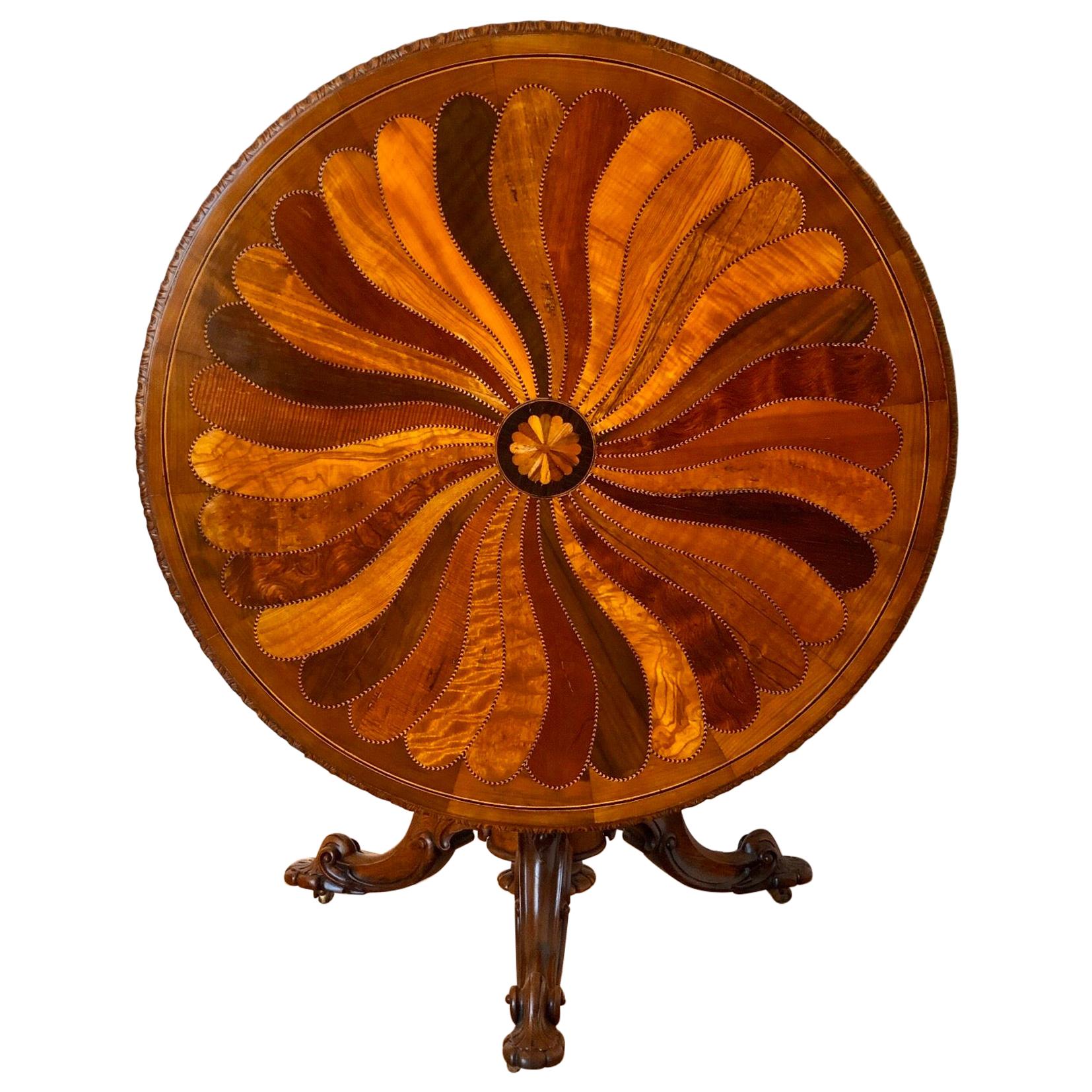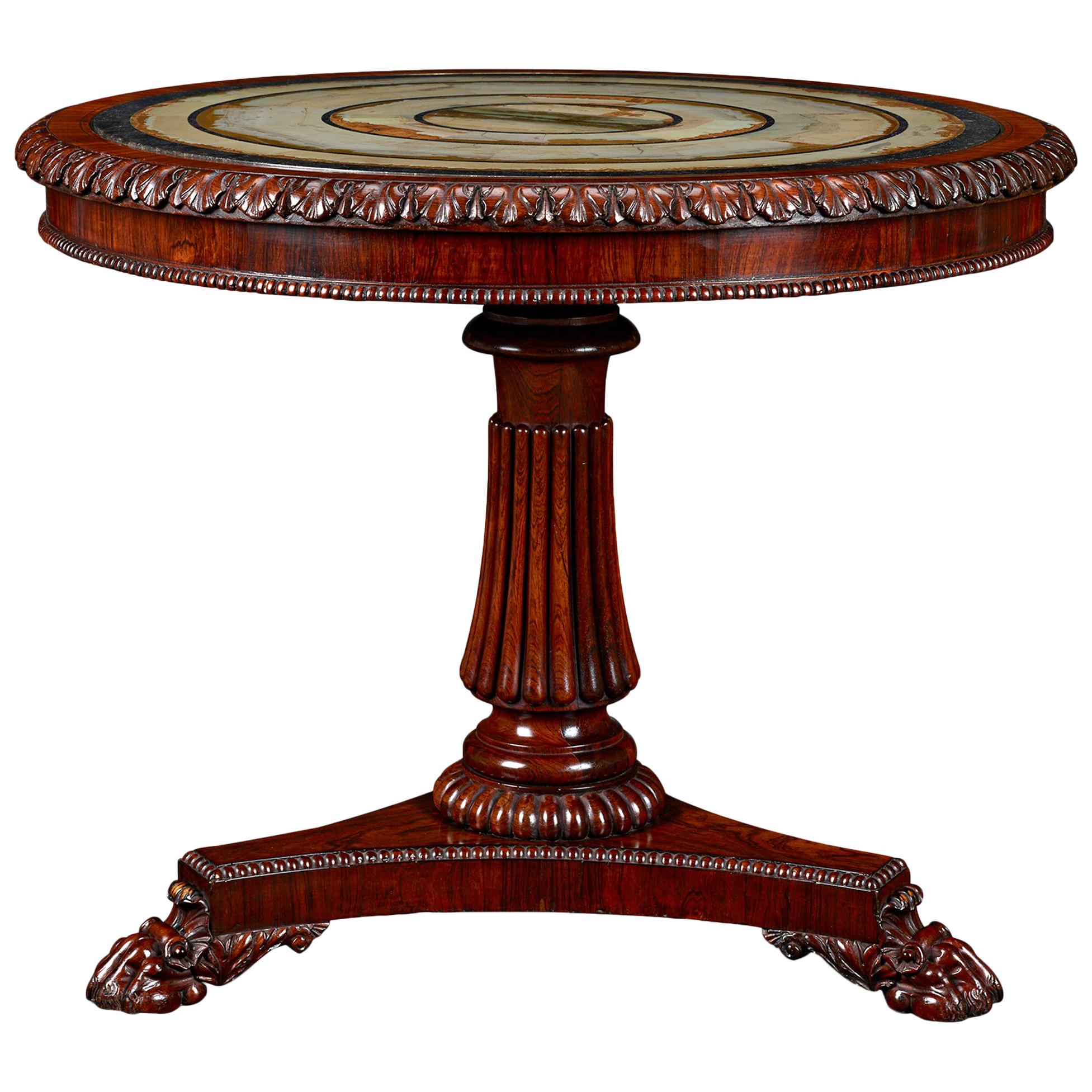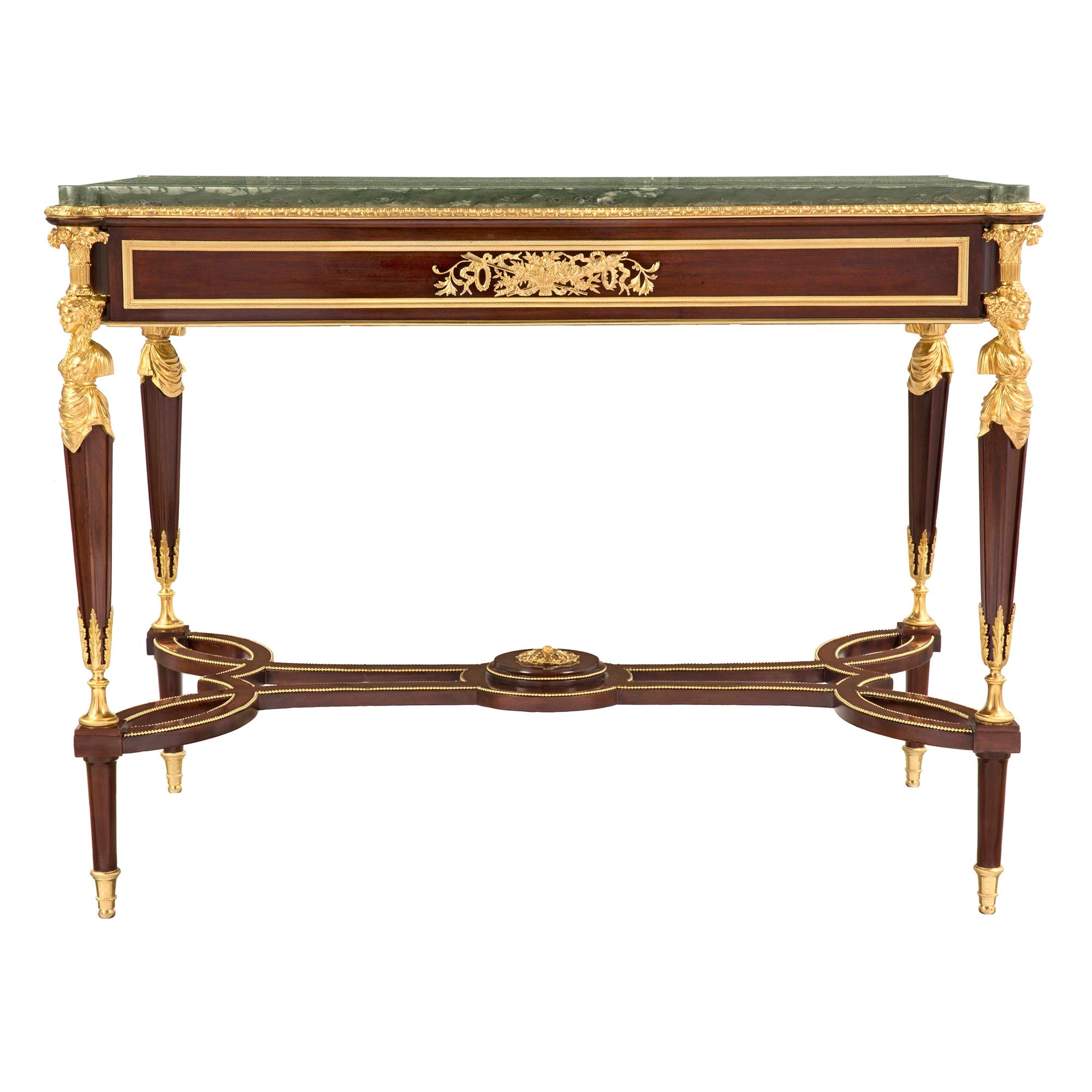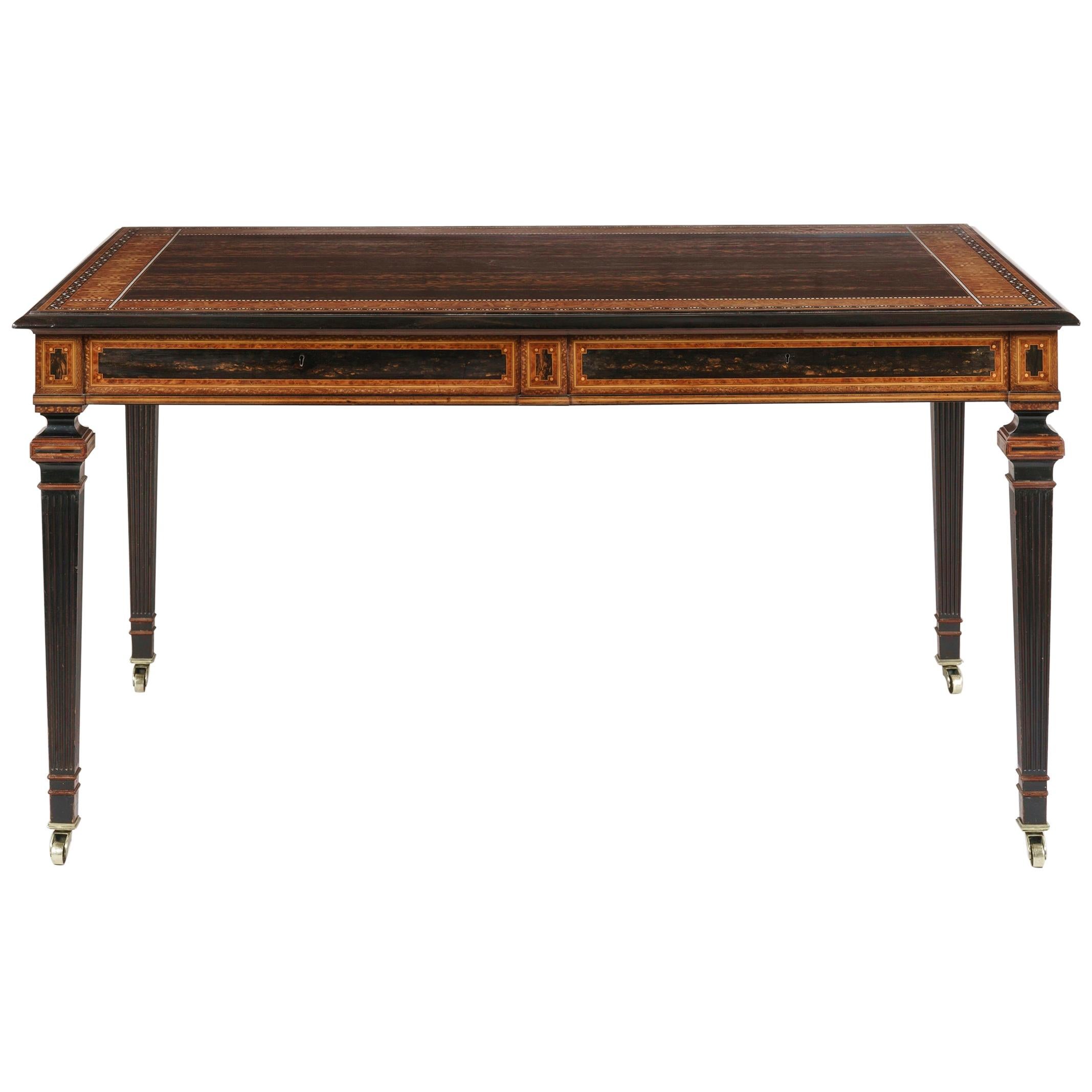Items Similar to 19th C Jamaican Mahogany Round Specimen Table, attributed to Ralph Turnbull
Want more images or videos?
Request additional images or videos from the seller
1 of 6
19th C Jamaican Mahogany Round Specimen Table, attributed to Ralph Turnbull
About the Item
This table is attributed to Ralph Turnbull, who was a famous Jamaican cabinet maker in the 19th century. Constructed of mahogany with palmwood and satinwood as secondary materials, it features unique inlay and because of its size, it is compatible with most spaces.
- Dimensions:Height: 29 in (73.66 cm)Width: 24 in (60.96 cm)Depth: 24 in (60.96 cm)
- Style:British Colonial (Of the Period)
- Materials and Techniques:
- Place of Origin:Jamaica
- Period:
- Date of Manufacture:1830
- Condition:Wear consistent with age and use.
- Seller Location:Charleston, SC
- Reference Number:
About the Seller
5.0
Vetted Seller
These experienced sellers undergo a comprehensive evaluation by our team of in-house experts.
Established in 1996
1stDibs seller since 2010
150 sales on 1stDibs
Typical response time: 1 hour
- ShippingRetrieving quote...Ships From: Charleston, SC
- Return PolicyThis item cannot be returned.
More From This SellerView All
- 19th C Jamaican Minature Spice Cabinet, attributed to Ralph TurnbullLocated in Charleston, SCThis Caribbean miniature demipress/spice cabinet was made in Jamaica in the 1830's and is attributed to Ralph Turnbull. This British Colonial piece is c...Category
Antique 19th Century Caribbean British Colonial Cabinets
MaterialsCoconut, Mahogany, Rosewood, Satinwood
- British Ceylon Style Specimen Round Tilt-Top Table , 19th CenturyLocated in Charleston, SCThis British Colonial center table uses exotic wood veneers to create a spectacular spiral, fanning clockwise with contrasting exotic specimen woods ...Category
Antique Mid-19th Century Sri Lankan British Colonial Center Tables
MaterialsRosewood, Mahogany
- Early 19th Century Caribbean Mahogany Tilt-Top Breakfast Center TableLocated in Charleston, SCThis West Indies center table has an English influence. This piece is published in " West Indian Antique Furniture of the Lesser Antilles...Category
Antique Early 19th Century Bajan British Colonial Tables
MaterialsBrass
- 19th Century Irish Specimen Marble-Top Rosewood Center Table or Chess TableLocated in Charleston, SCThis extraordinary octagonal center table has a specimen marble chess table-top with Pietra Dura semi-precious stones. The late Regency specimen mar...Category
Antique 19th Century Irish Regency Center Tables
MaterialsMarble
- 19th Century Jamaican Regency Mahogany Tilt-Top Breakfast TableLocated in Charleston, SCThis West Indies tilt-top breakfast table was created in Jamaica in the early 19th century, circa 1800. The table is made of solid mahogany from the Caribbean and is mounted on a sta...Category
Antique Early 19th Century Caribbean British Colonial Dining Room Tables
MaterialsBrass
- Pair of Early 19th Century Jamaican Regency Mahogany Occasional TablesLocated in Charleston, SCA matching pair of early 19th century Jamaican Regency mahogany occasional tables, circa 1830, featuring turned pedestal base on tripod base. West Indies...Category
Antique Early 19th Century Jamaican British Colonial End Tables
MaterialsMahogany
You May Also Like
- 19th Century Marquetry Occasional Table in the Manner of Ralph TurnbullLocated in Reepham, GBA beautifully detailed and striking piece. A Mid-19th century veneered centre table, with a profusely inlaid top which incorporates many exotic tropical hardwoods. The table top i...Category
Antique 19th Century North American Center Tables
MaterialsWood
- 19th Century Rosewood and Pietra Paesina Specimen Table AttributedBy Gillows of Lancaster & LondonLocated in New Orleans, LAPietra Paesina is one of the most scarce and wondrous stones on earth, and the surface of this exceptional early 19th-century center table is inset with...Category
Antique Early 19th Century English Regency Center Tables
MaterialsMarble
- French 19th Century Mahogany, Ormolu and Marble Table, Attributed to DassonBy Henry DassonLocated in West Palm Beach, FLA stunning and extremely high quality French 19th century Louis XVI style mahogany, ormolu and vert campan marble side/center table, after a model by Adam Weisweiler and attributed to Henry Dasson. The table is raised by fine topie shaped feet with elegant circular tapered supports. Each leg displays a unique square tapered shape with a carved recessed design and elegant foliate ormolu movements which encase the leg. Each are connected by a fine mahogany stretcher with elegant beaded ormolu bands and a lovely central floral reserve. Above are impressive richly chased caryatids with lovely flowing drape and tied hair below intricately detailed floral baskets. The straight frieze displays a recessed panel framed in a fine mottled ormolu band. The frieze is centered by a charming and richly chased pierced ormolu mount with a central floral bouquet and crossed staff...Category
Antique 19th Century French Louis XVI Center Tables
MaterialsMarble, Ormolu
- Exceptional 19th Century Centre Table Attributed to Holland & SonsBy Holland & SonsLocated in London, by appointment only• One of the finest pieces of 19th century English furniture ever made • Firmly attributed to the Royal cabinetmaker, Holland & Sons • Made using stunning rare & exotic timbers, Th...Category
Antique Mid-19th Century British Early Victorian Center Tables
MaterialsOrmolu
- 19th Century Coromandel and Inlaid Table Attributed to Jackson & GrahamBy Jackson & GrahamLocated in London, GBA magnificent library table Attributed to Jackson & Graham Of free standing rectangular form, constructed in coromandel, with inlays in thuya, ebony, boxwood, and honeysuckle; the fluted legs rising from square brass castor-shod feet; the frieze housing two lockable drawers fitted with rare ‘tamper proof’ Chubb locks and having quadrant moulded cedar lined interiors; the platform having a central panel of beautifully chosen matched coromandel veneers, with an outer guard border of a running pattern of stylised anthemions; the ebony edges having a thumb nail moulding, circa 1865 The firm of Jackson & Graham established in 1836 by Thomas Jackson and Peter Graham at 37 Oxford Street London, and for the next fifty years produced predominately high quality furniture and represented Britain at many of the international exhibitions. Their clients included Queen Victoria, Napoleon III, the Grand Khedive of Cairo and the royal palace in Siam. They were particularly noted for their fine marquetry work, the use of Wedgwood plaques, rare woods, and fine casting of bronze mounts. They engaged the leading designers of the period, inter alia, Owen Jones, Bruce Talbert, Alfred Lorimer and Eugene Prignot. In the mid-1850s the workforce was recorded as 250, and by 1875, the company was employing 600 workers. They were feted exhibitors at many of the Great Exhibitions of the 19th century, and frequent prize winners. At the Paris International Exhibition of 1878, the furniture jury noted of them ‘ the workmanship is so perfect that even with the aid of a magnifying glass scarcely the slightest imperfection is to be found’. In 1885 the company was absorbed by Collinson and Lock, who continued their standard of excellence. Charles Chubb was apprenticed as a blacksmith before starting business as a ships’ ironmonger in Winchester. Jeremiah soon joined the business, and by 1818 the brothers had branched out into lockmaking, founding the famous Chubb Company. The business really got started when Jeremiah Chubb patented his new ‘detector lock’ in 1818. The lock was constructed so that if someone tried to pick it or open it with the wrong key it became inoperable. To make the lock work again the owner had to use a special key supplied with the lock. The aim of the detector lock was to prevent burglaries, and to warn the owner that someone had tried to break into their property. The lock soon became popular, and sales of the Chubbs’ products increased even more when they won a government competition to design a lock that could only be opened using its own key. After the invention of the detector lock, the Chubbs decided to move to Wolverhampton, which already had an established lock making industry. By 1838 they were making 28,000 locks a year at their Wolverhampton factory. Another product was added to the Chubb range in 1835 when a patent was taken out for a burglar resistant safe, and in 1837 the Chubb safe...Category
Antique 19th Century English Tables
MaterialsBrass
- Late 19th c. Roman Specimen Marble Topped TableLocated in Hudson, NYThis very fine table made in Rome in the very late 19th or early 20th century is of dramatic design and using costly material. The base carved from solid travertine is in a Renaissan...Category
Antique 19th Century Italian Renaissance Center Tables
MaterialsStone, Travertine, Marble
Recently Viewed
View AllMore Ways To Browse
Mahogany Round
Round Mahagony Table
Mahogany Round Table
Round C Table
Antique Round Mahogany Table
Mahogany Antique Round Table
Antique Mahogany Round Table
Specimen Table
19th Century Round Center Table
Round Cabinet Table
Colonial Mahogany
19th Century British Tables
19th Century British Colonial Furniture
Round Mahogany Center
Round Mahogany Center Table
Round Orange Table
19th Century Specimen Table
British Inlay





